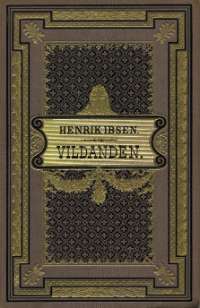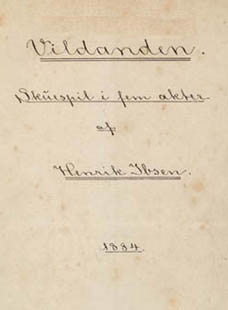

Brief description
The first plans for The Wild Duck originated in the winter of 1882/83. However, the first draft of the play was not begun until 20 April 1884. A number of notes dating from various stages in the creative process have been preserved. In one of these Ibsen writes:
The metaphor of the wild duck: when they are wounded they sink straight to the bottom, the stubborn devils, and hold on with their beaks –; but if you have a good dog, and the water is shallow, then –
Hedvig as a wild duck –
Gregers experiences of childrens' first, deepest pain. Not the sorrows of love; no, family pain, – what is painful in home situations –
[read the note in original handwriting]
«The metaphor of the wild duck» must refer to Welhavens poem «The Sea Bird»; an important source of inspiration for the play.
On 20 April 1884 Ibsen started on the first act in the first draft of The Wild Duck. He spent eight days on this act. The second act was started on 2 May, but broken off midway. The first and second acts were then rewritten up to 24 May. The third and fourth acts were written in the period between 25 May and 8 June, while the fifth act was done between the 9 and 13 of June. The next day Ibsen wrote to his Danish publisher Frederik Hegel:
I now have the pleasure of informing you that I completed the draft of my new play yesterday. The play is in five acts and as far as I can see will consist of about 200 printed pages, or possibly a little more.
So now the fair copy remains to be done, and I shall start on that tomorrow. As usual, however, this will not be a mere copy of the draft, but rather a re-writing of the dialogue. So this will take some time; but I take it for granted that as long as nothing unforeseen happens, the complete manuscript should be in your hands by the middle of September.
This play does not deal with political or social or public issues at all. It has entirely to do with family life. It will doubtless cause some discussion, but it will not offend anyone.
[read the letter in HISe]
At the end of June Ibsen left Rome for Gossensass. He spent the next four months there, mostly alone, while Suzannah and Sigurd were staying in Norway. He started the work of writing the fair copy several times – at least three – but in the course of July the first, second and third acts were ready in their final version. The fourth act was finished on 17 August, and the fifth and last act on 30 August.
On 2 September 1884 he sent the fair copy of the manuscript to Hegel, writing:
With this letter I am enclosing the manuscript of my new play «The Wild Duck», which has occupied me for the past four months, so that I shall miss it to some extent after having to part with it. In spite of their many weaknesses, the characters in this play have become dear to me after having to do with them daily for such a long time; but I hope they will also find good, kind friends, among the large reading public and not least among the acting community in that they all, without exception, offer rewarding tasks.
[read the letter in HISe]
The Wild Duck came out on 11 November 1884 at Gyldendalske Boghandels Forlag (F. Hegel & Søn) in Copenhagen and Christiania in an edition of 8 000 copies.
Both reviewers and readers were rather puzzled by the play, and Henrik Jægers comment was to the point: «The public do not know what to make of it, and are made no wiser by the criticism, as one paper says one thing and another something else».
Ibsen was prepared for this, to a great extent. In the letter to Hegel quoted above, dated 2 September 1884, he writes:
In some ways this new play has a place of its own in my dramatic production; the method differs in various respects from my earlier method, but I will not go into this in more detail. The critics will find these differences, I hope; at any rate they will find a great deal to argue about, and a great deal to interpret.
It is said that The Wild Duck introduces the symbolic phase in Ibsen's writing, and it was mainly the use of symbols in the play that seemed strange and confusing to its readers. In spite of this the play sold very well. A second edition of 2 000 copies was printed and already published on 1 December 1884.
The play had its first performance on 9 January 1885 at Den nationale Scene in Bergen. The production was a success, largely owing to its director, Gunnar Heiberg.
Two days later the play had its first night at Christiania Theater. During the month of January it was also produced at Svenska (Swedish) Teatern in Helsingfors (16 January), in Aalborg (25 January) and at Dramaten in Stockholm (30 January).
(From ibsen.net)
Plot summary
Hjalmar Ekdal, a photographer, lives with his wife Gina and daughter Hedvig in a combined studio and apartment with a large adjoining loft where they keep chickens and rabbits. Living with the family is old Ekdal, a former lieutenant who was earlier imprisoned for a financial offence for which Werle, a wholesaler, was actually responsible. Gina was Werle's housekeeper earlier.
At the beginning of the play his son, Gregers Werle, has come home to attend a dinner given by his father. Gregers discovers that Gina Ekdal was his father's mistress before she married Hjalmar, and that his father had brought the two of them together and helped them financially.
Gregers now considers it his duty to get Hjalmar to see the truth behind his marriage so that he and Gina can live together in a marriage based on truth. Hjalmar confronts Gina with her background and asks her whether he is Hedvig's father. Gina replies that she does not know, and in distraction Hjalmar rejects Hedvig as his daughter. Meanwhile Gregers has convinced Hedvig that she can win back her father's love by sacrificing the wild duck that lives in the loft and to which she is deeply attached. But Hedvig shoots herself instead of the wild duck, and the play ends with general despair at the death of the child.
(Source: Merete Morken Andersen, Ibsenhåndboken, Gyldendal Norsk Forlag, 1995.)
Read The Wild Duck (in Norwegian)
In the online version of the official Ibsen edition (HISe), you can read The Wild Duck in various formats. This content is currently only available in Norwegian. Follow the links below to read the play:
Introduction to the work (in Norwegian)
The online version of the official Ibsen edition (HISe) offers extensive information about The Wild Duck in Norwegian. Follow the links below to read about various aspects connected to the play.
Reviews
Here you can find reviews in full text and an overview of registered reviews in various languages.
- Reviews from Ibsen's life time in full text
- Reviews registered in the Ibsen bibliography (nb.no)
- Reviews registered in "Norsk litteraturkritikk" (UiO)
Translations
- The Multilingual Ibsen
- Translations in various languages
- Overview of translations from Ibsen's lifetime (HISe)